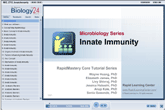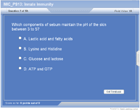Innate Immunity
| Topic Review on "Title": |
Innate Immunity:
- Is the basic resistance to disease that an organisms or individual has as a function of birth. It is the initial immune defense system.
- Is non-specific.
- At the species level it refers to the immune response that all members show to a pathogen.
- Within a species there exists subgroups such as race, gender etc. that may exhibit differences in immunity to pathogens.
- Individual immunity refers to differences in an individual’s response to a pathogen within a given race.
- Four Types of barriers to infections: anatomic, physiologic, phagocytic and inflammatory.
- Examples of these barriers: temperature, pH, enzymes and chemical, skin, mucous membranes, phagocytic or endocytic barriers, inflammatory barriers.
Organs Involved in Innate Immunity
- Eyes: tears wash away pathogens and have bacteriocidal enzymes.
- Skin: Difficult for a pathogen to penetrate, sweat creates high salt conditions, oil layer makes an inhospitable environment.
- Stomach: acid kills pathogens and sterilizes food.
- Nose: Mucus traps pathogens which are swallowed or blown out.
- Mouth: Natural microbiota prevents growth of opportunistic pathogens.
- Lungs: mucus lining of lungs traps pathogens and cilia move particles out to throat and it is swallowed.
- Large intestine: Natural microbiota prevents growth of opportunistic pathogens.
- Reproductive system: acid conditions and natural microbiota.
Innate Immunity Influences
- Age
- Nutrition
- Endocrine functions: disorders including diabetes, hyperthyroidism, adrenal dysfunction and stress.
Mechanisms of Innate Immunity
- Non-specific broad spectrum response.
- No lasting immunological memory.
- Has limited flexibility and repertoire.
- Responses are evolutionarily ancient.
|
| Rapid Study Kit for "Title": |
| Flash Movie |
Flash Game |
Flash Card |
| Core Concept Tutorial |
Problem Solving Drill |
Review Cheat Sheet |
 |
 |
 |
|
| "Title" Tutorial Summary : |
This module presents the concepts of Innate Immunity which is a nonspecific inherited immune system to prevent infection. This type of immunity acts on the species, race and individual levels. A given species may have an immunity to a pathogen however individuals or races within the species may have modified specific responses.
The primary mechanisms involved in innate immunity are presented. These mechanisms include: anatomic, physiologic, phagocytic and inflammatory barriers and responses. The organism uses a combination of responses and innate immunity retains no lasting immune memory.
|
| Tutorial Features: |
Specific Tutorial Features:
- Basic concepts of innate immunity.
- Species, race and individual parameters of innate immunity.
- Body systems involved in innate immunity.
- Factors that influence innate immunity.
- Mechanisms of innate immunity.
- Innate Immune responses: Anatomic, Physiologic, Phagocytic and Inflammatory.
Series Features:
- Images and diagrams showing the relationship between innate immunity and adaptive immunity.
- Concept map showing inter-connections of concepts.
- Definition slides introduce terms as they are needed.
- Examples given throughout to illustrate how the concepts apply.
- A concise summary is given at the conclusion of the tutorial.
|
| "Title" Topic List: |
Immune system consists of two processes: Innate Immunity and Adaptive Immunity.
Determinants affecting innate immunity, genetics and environmental factors.
There are specific organs and systems involved in innate immunity that are shared within defined groups such as species, races etc.
Organs and systems involved in innate immunity: eyes, skin, stomach, large intestine, nose, mouth, lungs and reproductive system.
The systems interact to complement each others innate immune functions, e.g. mucous in the nose traps pathogens and particles which are transported to the stomach where they are sterilized.
Innate immunity may be considered at the level of the species, race or individual.
Factors affecting innate immunity include: age, hormonal levels, nutrition and stress. |
See all 24 lessons in college biology, including concept tutorials, problem drills and cheat sheets:
Teach Yourself Microbiology Visually in 24 Hours
|